
Misunderstanding Jewry
Is Death to Everyone
Without a doubt, the Bible is a Jewish book either directly or indirectly; therefore, a correct understanding of biblical Jewry and historic Jewry is essential to proper hermeneutical interpretation of both the Old and New Testaments.
Church history has consistently failed in this endeavor leading to erroneous views and doctrines which has become ensconced in Christian tradition and thus, unassailable. Unfortunately, this has serious repercussions in understanding the Bible, and thus the Gospel in its fulness, and the interpretation of current national and world trends.
I do not have a Jewish background and was in my 40’s before I had spent half of my life inside America. As a military family we moved often and were not well integrated into Southern social life (many Army bases were located in the deep South), especially after integration of the services. This ostracization gave me a unique view both of American society and later of Christian traditions (I was saved in my late 20’s).
As I struggled to learn the Bible I went through several evolutions of thought. Being saved in a fundamental Baptist environment I learn a particular set of doctrines that condemned biblical Jewry (denial and crucifixion of Christ) while it promoted modern Jewry (nation of Israel). When I moved beyond that fundamental movement I began to reexamine my beliefs in light of the Bible. I read a great many books such as the works of Alfred Edersheim on Jewish life and culture as practiced in the Old Testament and the works of C. H. Mackintosh, “The Pentateuch” and his “Collected Writings”. My understanding of hermeneutical interpretation demanded that I study the Scriptures from the perspective of the particular writer and not from my current worldview; in other words, I was to “pull God’s meaning from the words” (exegesis) rather than read my modern meaning into the Bible (eisegesis). This journey was not appreciated by my contemporaries and I was prone to some enthusiastic errors such as wearing the Tallit and observing Passover. I have found balance as a Gentile Christian who is understanding the Jewish perspective of the Scriptures.
For example, let us examine a simple verse from Isaiah to understand more correctly what Isaiah saw in his vision of Christ in Heaven (Is 6:1). Isaiah sees Christ on His throne and makes the statement, at least as it is translated into most English Bibles, “the train of His robe filling the temple”. According to the Cambridge dictionary the definition of “train” is “the long part of a dress that trails behind the person wearing it”. The problem I have is that 1) Christ is sitting so there would be no trailing clothing behind Him (he would be sitting on it so it would not be filling the Temple) and 2) that is not what the Hebrew says! The Hebrew word (H8767) שׁוּל actually means the hem of a garment and its use in the Old Testament reference the bells and pomegranates that hung from the robe of the Jewish High Priest’s robe! Thus, the Western imagery of Christ as King on His Throne is not a correct interpretation of what Isaiah saw. He saw Christ as High Priest sitting in the Temple in Heaven with the Seraphim calling out, “Holy, Holy, Holy, is the Lord of hosts, the whole earth is full of His glory” (Is 6:3). Christ is presenting Himself to Isaiah as the High Priest for all the earth and the function of the High Priest is to make the sacrifice on the Mercy Seat of the Ark of the Covenant. Do we find this imagery elsewhere in Scripture for Scripture must define Scripture? Hebrews (Chapters 9-10) explain in great detail that the earthly tabernacle/temple was but a shadow or copy of the heavenly Temple with Christ as High Priest who offered Himself as sacrifice. at the appropriate time in history. Thus, Christ is sending Isaiah out with the message for the Jews to prepare themselves for the coming sacrifice of Christ for sin for the entire world! Indeed, this is the message of the entire writing of Isaiah with the caveat that the Jews would ignore his message, and their Messiah, which they did to the extent that they facilitated the sacrifice of their Messiah!
This work of Christ as High Priest is often missed by today’s churches because they either have little real knowledge of true Jewry or they have replaced the Jews with themselves and thus interpret Scriptures from their own worldview; that is, they read their meaning into Scripture making it say what they already wish to hear thus fulfilling the cry of Isaiah that “hearing they shall not hear” and “seeing they shall not see” (Is 6:8-10). The work of Christ the High Priest in the everyday life of the believer is minimized by the mistranslation of Scripture.
For example, Hebrews (4:12) reads: “For the word of God is living and active and sharper than any two-edged sword, and piercing as far as the division of soul and spirit, of both joints and marrow, and able to judge the thoughts and intentions of the heart.” But this is not in the Greek; rather, the imagery is of a sacrificial knife used to flay open and examine the animal insuring it will be suitable as a sacrifice (He 4:12-14). This is consistent with Paul who writes that we are living sacrifices (Ro 12:1) and that he was being “poured out” as a “drink offering” (Ph 2:17; 2Ti 4:6); i.e., his life on earth was nearing its in as the drink offering was the last offering of all the offerings. The correct understanding of Jewry gives us a richer understanding of Christ, and His work in us than allowed by the traditional translations. Swords are weapons of hacking and stabbing, not of examination. The correct understanding of the dress and duties of the Jewish priesthood points to a correct understanding of these passages.
In our next post I will discuss several ancient traditions that are not directly mentioned in the Scriptures but are certainly detailed in ancient Jewish writings. It was these traditions that Christ attacked but are not understood by the Gentile Church because they do not understand what Jewry became even during the time of Moses.
